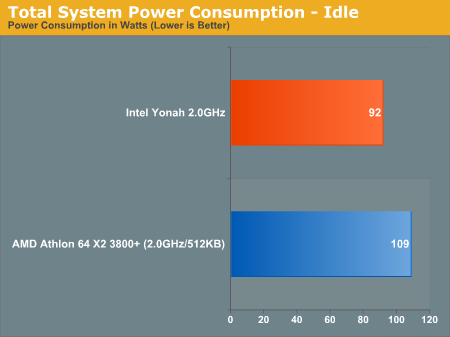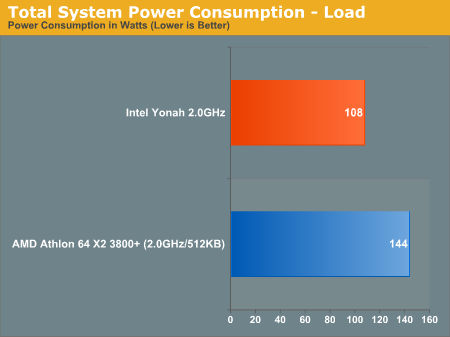Intel Yonah Performance Preview - Part I: The Exclusive First Look at Yonah
by Anand Lal Shimpi on November 30, 2005 2:50 AM EST- Posted in
- CPUs
Power Consumption and Final Words
At 2.0GHz, Yonah is basically equal to, if not slightly slower than an Athlon 64 X2 running at the same clock speed in virtually all of the tests we ran. The important distinction here is that Intel is able to achieve that level of performance, without an on-die memory controller. But there is also one more thing to note, Yonah can offer that level of performance with significantly lower power consumption:


While the Yonah and Athlon 64 X2 systems consumed relatively similar power at idle, Yonah hardly eats up any more power under full load. In fact, a 2.0GHz Yonah under 100% load consumes less power than an Athlon 64 X2 3800+ at idle. Obviously Intel has the advantage of being on a much lower power 65nm process, but it won't be until the second half of next year before we see any Athlon 64 X2s at 65nm, so it is an advantage that Intel will have for quite some time.
Although we didn't consider it as such here today , Yonah will be quite impressive on notebooks. The thought of having such a cool running dual core processor in a notebook is honestly amazing, and the performance difference (especially for multitaskers) over what we have today will be significant. The other thing to keep in mind is that when you go from a single core to a dual core Pentium M notebook, you won't be giving up anything at all. On the desktop side, you normally give up clock speed for dual core support, but Yonah will be running at very similar frequencies to what Dothan is running at today. In other words, you won't be giving up single threaded performance in favor of multi-threaded performance - you'll get the whole package.
As a desktop contender, Yonah is a bit of a mixed bag. While its performance in content creation applications has definitely improved over the single core Dothan, it still falls behind the Athlon 64 X2 in a handful of areas. Intel still needs to improve their video encoding and gaming performance, but it looks like we may have to wait for Conroe and Merom for that.










135 Comments
View All Comments
bhtooefr - Wednesday, November 30, 2005 - link
Also, isn't there a way to disable the second core in BIOS?I think it's definitely possible to make your dual-core chip into a single-core for testing.
Slaimus - Wednesday, November 30, 2005 - link
No, since it is a CPU with double execution units, rather than 2 CPUs linked together.fitten - Wednesday, November 30, 2005 - link
I've not seen that stated anywhere. What I've seen is that there are two cores, two independent L1 caches, and a shared L2 cache.Anemone - Wednesday, November 30, 2005 - link
The reason it was compared against the X2 is simply because that is where the next gen Turion "may" land in performance. Power consumption in this test is nice, but not really relevant to the new Turion, nor is it relevant to the mobile arena where AMD with integrated controller does well against P-M plus external controller consumption (well though Intel is better so far).I had a feeling things were going to turn out this way. That cache on the P-M is really what makes it such a nicely performing chip. Weakening that was really the telling test in all this. It's nice that you put that test first. The dual core Turion is going to be very close in release timing to Yonah, and quite a few samples of the chip are already out there, but I'd bet AMD is keeping its cards close, as it has less of a need to prove a point.
However, from a mobile perspective AMD's use of Via and ATI chipsets really will be the telling factor, and will impact the "you get it all" bundle of a notebook. Where, after over a year, is Nvidia and a pci-e mobile chipset for AMD? Turion is almost out the door and they haven't even spoken up yet. That's probably because they won't be there when Turion releases. If Nvidia had no chipset on the desktop, the competition would be starkly different right now, and a good many folks know this to be true. So I'm expecting the dual core Turion to do incredibly well. 64 bit isn't an end all be all, but it will be a wonderful perk when Vista comes, and Vista will be here sooner than previously expected. Power consumption "may" favor Yonah, however Intel is doing what they always do, when a chip performs so-so, they push up the clockspeed. When they find out what Turion has on the table, they'll put out the EE version of Yonah to try to match it. THAT I bet, won't be so power friendly.
Intel is improving on Yonah with Conroe. But remember that the low latency L2 is what gave the Dothan its ability to stand in the A64 arena. That got lowered and we see the results. Now imagine what will happen when they "gently" increase the pipeline of Conroe vs P-M/Yonah. It'll drop a bit again. Against that you'll have architecture improvements and higher clockspeed (Conroe is expected to clock higher). That might end up making Conroe only "slightly" better than Yonah. That is why the marketing of th two can overlap, probably.
So IF (and it's not promising) Nvidia gets the NF4 into a mobile format and gets builders to use it on the new Turion dual cores, we might see some interesting things from the AMD side. If not, they stay as now, a niche market only. ATI chipsets aren't going to change that, much as they have not done much to the desktop side of things.
IF Yonah clocks at 2.6ghz you may see some competitive desktop systems to A64 X2's. It will rule the mobile roost unless the above happens for AMD. Conroe had better make some dramatic improvements to even Yonah's ability, though I'm doubtful, or putting both Yonah and Conroe on the desktop will simply hand even more of the market to AMD. On the mobile front, again unless the above happens for AMD/Nvidia on a mobile chipset, you will watch Yonah/Conroe rule the mobile roost.
:)
Griswold - Wednesday, November 30, 2005 - link
Intel just now managed to close the gap between them and AMD as far as dual core is concerned. I dont care if one is a mobile part and the other is not, mobile computing is of no interest to me and even less dual core mobiles. But it gives a good idea of what to expect.The numbers are there. Yonah isnt groundbreaking besides the fact that it is a dual core - and the desktop versions probably wont be either. Wow, thats late...
nserra - Wednesday, November 30, 2005 - link
TG Daily: What is your reason for not including support for 64-bit technology in Yonah? Why is it going to be supported only in Meron?Perlmutter: Like everything in technology or life, it is all a matter of timing. Integrating unneeded features into a processor means a waste of power consumption. Our assumption was, and still is, that 64-bit extensions are not the most important thing required from a processor, not even in the beginning of 2006. We believe this will change with Windows Vista, when applications start migrating to 64-bit, and we want to be ready then, and not a minute earlier.
Furen - Wednesday, November 30, 2005 - link
64-bit extensions = more transistors, which means higher power consumption.Donegrim - Wednesday, November 30, 2005 - link
If this is cheaper than the X2 3800, and overclocks really well on the desktop (say, 2.7-3ghz or so), then I could see myself being tempted by it. As long as the 'secret' motherboard isn't as ridiculously overpriced as current dothan desktops.Griswold - Wednesday, November 30, 2005 - link
WHat makes you think that thing will go to 2.7-3ghz? *laff*Donegrim - Wednesday, November 30, 2005 - link
Well the x2 3800 that consumes much more power (therefore is hotter) consistently goes to at least 2.5ghz, so I don't think it's unrealistic for a lower power chip to go further. Plus the FSB is nice and low, which makes for a good start with the overclocking.